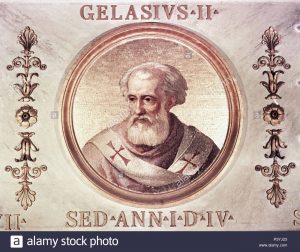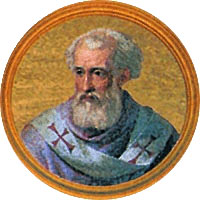There was a Chinappi named Cosmo-Tommaso. He lived in Gaeta.
He was the son of Marciano Chinappi and Amilia Di Tucci.
Many of his friends called him “Paparome”. Loosely translated it refers to the “Pope In Rome.”
His nickname came about because of the legend that he descended from a family line, that was related to a Pope of the Catholic Church.
Which Pope? No one knows. It was a legend that people tended to believe.
One day, a stranger came into the village of Gaeta. Cosmo-Tommaso was speaking to him, and the stranger asked for someone to vouche for Cosmo-Tommaso so the stranger could know that Tommaso was trust-worthy.
One of Tommaso’s long time friends was near by and he volunteered to vouche for Cosmo-Tommaso.
The friend said, I have known Cosmo-Tommaso Paparome all of my life! We have been friends for almost 20 yrs!
At that moment, Cosmo-Tommaso said to his friend: “Paparome?! My name is CHINAPPI!”
The friend was shocked. “Chinappi? I always thought your name was Paparome!
NO! said Cosmo-Tommaso. It’s always been Chinappi, everyone just calls me that.
This is a story about my grandfather “Paparome”
It was passed down to my parents who shared it with me.
But it did get me thinking.
Growing up, I had heard the legend as well that there was a Chinappi that had become a Pope, or that there was a Pope related to a Chinappi in some way.
I decided to see what I could find online, and figuring that in Chinappi genealogy, all roads lead to Gaeta, I figured I would look for Popes that had roots in Gaeta.
I found one:
Pope Gelasius II

Papacy began 24 January 1118
Papacy ended 29 January 1119
Personal details
Birth name Giovanni Caetani
Born 1060–64 Gaeta, Principality of Capua
Died 29 January 1119 Cluny, Duchy of Burgundy, Kingdom of France
Acting Chancellor of the Holy Roman Church (1088)
Cardinal-Deacon of Santa Maria in Cosmedin (1088–1118)
Chancellor of the Holy Roman Church (1089–1118)
Pope Gelasius II (c. 1060/1064 – 29 January 1119), born Giovanni Caetani or Giovanni da Gaeta (also called Coniulo), [1] was Pope from 24 January 1118 to his death in 1119. A monk of Monte Cassino and chancellor of Pope Paschal II, Caetani was unanimously elected to succeed him. In doing so he also succeeded to the conflicts with Emperor Henry V over investiture. Gelasius spent a good part of his brief papacy in exile.
He was born between 1060 and 1064 at Gaeta into the Pisan branch of the Caetani family, and became a monk of Monte Cassino. Pope Urban II, who wished to improve the style of papal documents, brought him to Rome and made Caetani a papal subdeacon (August 1088) and cardinal deacon of Santa Maria in Cosmedin (probably on 23 September 1088). As chancellor of the Holy Roman Church from 1089 to 1118, he drastically reformed the papal administration, establishing a permanent staff of clerks for the papacy, overcoming the previous custom of relying on Roman notaries to write papal documents, and introducing the minuscule curial script. His tenure also established the precedent of the papal chancellor always being a cardinal and holding the office for life or until elected pope.
Shortly after his unanimous election to succeed Pope Paschal II in 1118, he was seized by Cencio II Frangipane, a partisan of Holy Roman Emperor Henry V, but was freed by a general uprising of the Romans on his behalf.[2]
Henry V sought to enforce the privilege of investiture conceded (and later revoked in 1112) by the papacy, under duress, by Paschal II. He drove Gelasius II from Rome in March 1118, pronounced his election null and void, and set up Maurice Bourdin, Archbishop of Braga, as antipope under the name of Gregory VIII.

Gelasius II fled to Gaeta, where he was ordained a priest on 9 March 1118 and on the following day received episcopal consecration. He at once excommunicated Henry V and the antipope and, under Norman protection, was able to return to Rome in July. But the disturbances of the imperialist party, especially those of the Frangipani, who attacked the Pope while celebrating Mass in the church of St. Prassede, compelled Gelasius II to go once more into exile. He set out for France, consecrating the cathedral of Pisa on the way, and arrived at Marseille in October. He was received with great enthusiasm at Avignon, Montpellier and other cities, held a synod at Vienne in January 1119, and was planning to hold a general council to settle the investiture contest when he died at Abbey of Cluny.
source: en.wikipedia.org/wiki/Pope_Gelasius_II
Have you heard the Chinappi Pope stories as well?
Do you have a different Pope that it might be?
Ask your grandparents and share your story here.